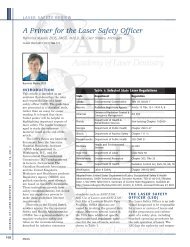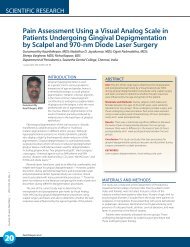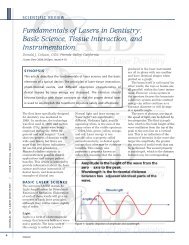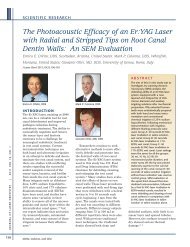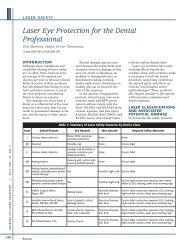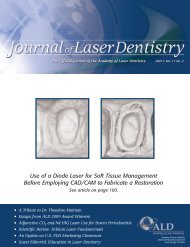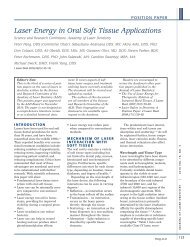Create successful ePaper yourself
Turn your PDF publications into a flip-book with our unique Google optimized e-Paper software.
J O U R N A L O F L A S E R D E N T I S T R Y | 2 011 V O L . 19 , N O . 3<br />
306<br />
R E S E A R C H A B S T R A C T S<br />
E F F E C T S O F T H E N D : YA G D E N TA L L A S E R O N P L A S M A - S P R AY E D<br />
A N D H Y D R O X YA PAT I T E - C OAT E D T I TA N I U M D E N TA L I M P L A N T S :<br />
S U R FA C E A LT E R AT I O N A N D AT T E M P T E D S T E R I L I Z AT I O N<br />
The Nd:YAG dental laser has been recommended for a<br />
number <strong>of</strong> applications, including the decontamination<br />
or sterilization <strong>of</strong> surfaces <strong>of</strong> dental implants that are<br />
diseased or failing. The effects <strong>of</strong> laser irradiation in<br />
vitro (1) on the surface properties <strong>of</strong> plasma-sprayed<br />
titanium and plasma-sprayed hydroxyapatite-coated<br />
titanium dental implants, and (2) on the potential to<br />
sterilize those surfaces after contamination with spores<br />
<strong>of</strong> Bacillus subtilis have been examined. Surface effects<br />
were examined by scanning electron microscopy, energy<br />
dispersive spectroscopy, and X-ray diffraction after<br />
laser irradiation at 0.3, 2.0, and 3.0 W using either<br />
contact or noncontact handpieces. Controls received no<br />
I N V I T R O E VA LU AT I O N O F T H E B I O C O M PAT I B I L I T Y O F<br />
C O N TA M I N AT E D I M P L A N T S U R FA C E S T R E AT E D W I T H<br />
A N E R : YA G L A S E R A N D A N A I R P O W D E R S Y S T E M<br />
Matthias Kreisler, Wolfgang Kohnen, Ann-Babett Christ<strong>of</strong>fers,<br />
Hermann Götz, Bernd Jansen, Heinz Duschner, Bernd d’Hoedt<br />
Titanium platelets with a sand-blasted and acid-etched<br />
surface were coated with bovine serum albumin and<br />
incubated with a suspension <strong>of</strong> Porphyromonas gingivalis<br />
(ATCC 33277). Four groups with a total <strong>of</strong> 48 specimens<br />
were formed. <strong>Laser</strong> irradiation <strong>of</strong> the specimens (n = 12)<br />
was performed on a computer-controlled XY translation<br />
stage at pulse energy 60 mJ and frequency 10 pps.<br />
Twelve specimens were treated with an air powder<br />
system. After the respective treatment, human gingival<br />
fibroblasts were incubated on the specimens. The proliferation<br />
rate was determined by means <strong>of</strong> fluorescence<br />
activity <strong>of</strong> a redox indicator (Alamar Blue Assay) which is<br />
reduced by metabolic activity related to cellular growth.<br />
Proliferation was determined up to 72 h. Contaminated<br />
and nontreated as well as sterile specimens served as<br />
positive and negative controls. Proliferation activity was<br />
Carl M. Block, John A. Mayo, Gerald H. Evans<br />
Louisiana State University Medical Center, New Orleans, Louisiana<br />
Int J Oral Maxill<strong>of</strong>ac Implants 1992;7(4):441-449<br />
Johannes Gutenberg-University Mainz, Mainz, Germany<br />
Clin Oral Implants Res 2005;16(1):36-43<br />
laser irradiation. Melting, loss <strong>of</strong> porosity, and other<br />
surface alterations were observed on both types <strong>of</strong><br />
implants, even with the lowest power setting. For the<br />
sterilization study, both types <strong>of</strong> implants were first<br />
sterilized by exposure to ethylene oxide and then<br />
contaminated with spores <strong>of</strong> B. subtilis. After laser irradiation,<br />
the implants were transferred to sterile growth<br />
medium and incubated. <strong>Laser</strong> irradiation did not sterilize<br />
either type <strong>of</strong> implant. The spore-contaminated<br />
implants in the control group were successfully sterilized<br />
with ethylene oxide.<br />
Copyright 1992 Quintessence Publishing Co., Inc. nn<br />
significantly (Mann-Whitney U-test, P < 0.05) reduced on<br />
contaminated and nontreated platelets when compared<br />
to sterile specimens. Both on laser as well as air powdertreated<br />
specimens, cell growth was not significantly<br />
different from that on sterile specimens. Air powder<br />
treatment led to microscopically visible alterations <strong>of</strong> the<br />
implant surface whereas laser-treated surfaces remained<br />
unchanged. Both air powder and Er:YAG laser irradiation<br />
have a good potential to remove cytotoxic bacterial<br />
components from implant surfaces. At the irradiation<br />
parameters investigated, the Er:YAG laser ensures a reliable<br />
decontamination <strong>of</strong> implants in vitro without<br />
altering surface morphology.<br />
Copyright 2005 Blackwell Publishing and the European<br />
Association for Osseointegration nn





